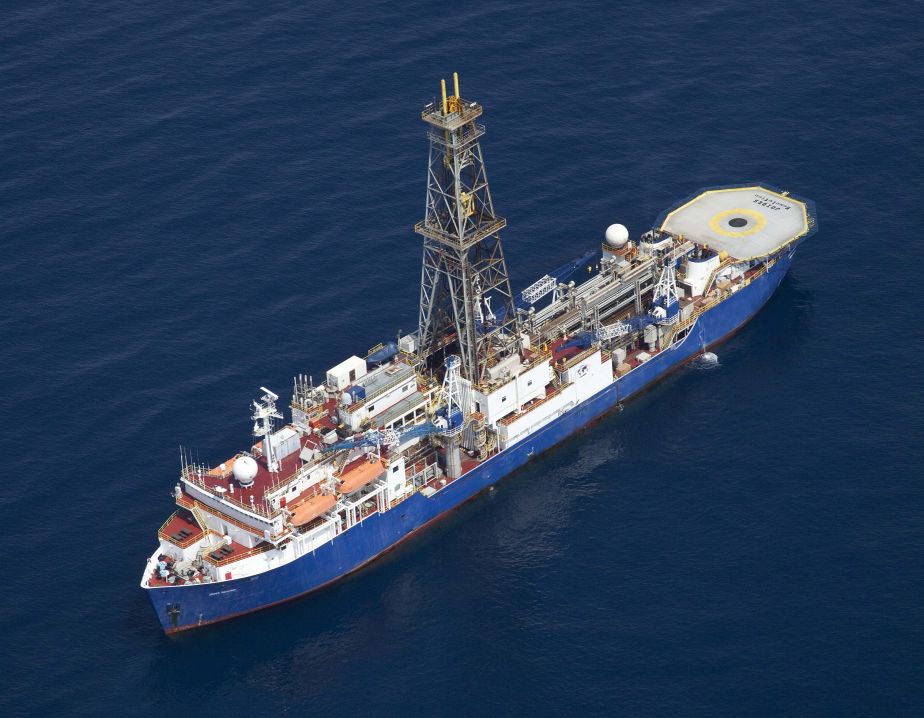Media Releases
High-tech deepsea drillship visits Townsville

The high-technology research drill ship JOIDES Resolution is visiting Townsville before it undertakes a two-month expedition that could help uncover the mysteries of the Pacific ‘Ring of Fire’ and the submerged continent of Zealandia.
The ship can operate in most water depths in the world’s oceans and is part of the International Ocean Discovery Program (IODP).
The ship has some impressive capabilities: in each drill hole it can gather more than a kilometre of continuous cores of sediment or rock. It’s 143 metres long with a drill tower 61 metres high, and generally carries a ship’s crew of 50 plus 55 scientists and science technicians.
The cores are studied on board and onshore to address global scientific problems in fields such as climate and oceanographic history, extreme climates, subseafloor life, plate tectonics and earthquake-generating zones, and the dynamics of island arcs and ocean basins.
During the forthcoming expedition it will recover about 5000 metres of sediment at a total of six drill sites. The sediment layers will reveal how a region hundreds of kilometres east of Australia, the Lord Howe Rise, has behaved in the past 50 million years. Much of the core will be obtained in Australia’s marine jurisdiction and will be used to better understand the sunken continent of Zealandia which extends from New Zealand northward to New Caledonia and almost to the North Queensland coast.
James Cook University geology lecturer, Dr James Daniell said “Australian universities contribute to the IODP program and, as a result, academics and students can access these large drillships and the data they collect. Every few years, the IODP program returns to Australian waters and the South Pacific to undertake research that is specific to our region and our oceans. Several JCU scientists are involved in IODP science.”
The core from the Lord Howe Rise will be analysed aboard the ship and afterwards by 30 scientists from around the world, including five from Australia and New Zealand. One of the co-chief scientists will be Professor Rupert Sutherland, from Victoria University, Wellington, the other is Professor is Jerry Dickens from Rice University, USA, who was once on the staff of James Cook University.
Co-chief scientist, Professor Rupert Sutherland said “I am interested in the tectonic aspects of the expedition and I am an expert on the formation of the Tasman Sea. The expedition aims to better understand the major changes in the global tectonic configuration that started about 50 million years ago, as the ‘Ring of Fire’ came into existence, with its trenches, earthquakes and volcanoes. This had a major impact on the eastern part of the sunken continent of Zealandia, as subduction of one tectonic plate under another began at the Kermadec-Tonga Trench.”
Zealandia was largely part of Australia until 75 million years ago, when it started to break away and move to the northeast. That movement halted 53 million years ago.
Co-chief scientist, Professor Jerry Dickens, is leading the environmental part of the expedition. He said “This is a key area to study the changes in global climate and oceanography, after Antarctica froze over and the world began to cool, with many fluctuations over time. As Australia moved north and the Tasman Sea developed, global circulation patterns changed and water depths over Zealandia fluctuated. This region has been important in influencing global changes for many millions of years.”
"Some 50 million years ago, a massive shift in plate movement happened in the Pacific Ocean," said Jamie Allan, a program director in NSF's Division of Ocean Sciences, which supports IODP. "It resulted in the diving of the Pacific Plate under New Zealand, the uplift of New Zealand above the waterline, and the development of a new arc of volcanoes. This IODP expedition will look at the timing and causes of these changes as well as at related changes in ocean circulation patterns and ultimately Earth's climate."
Although ocean drilling is carried out purely for scientific purposes, other scientists may use the information for applied purposes, such as identifying petroleum reserves.
Background
The large drill ships provided by IODP are the only such platforms available to non-industry scientists for undertaking research – and enable a range of scientific research studies that would otherwise be impossible, studying geoscience questions of global significance.
IODP is an international scientific ocean drilling program with 23 countries involved (including Australia and New Zealand), with an operational budget of $US180 million a year funded largely by the US, Europe and Japan. JOIDES Resolution (JR) is operated on behalf of the US National Science foundation by the JR Science Operator based at Texas A&M University https://www.iodp.org/.
The Australian and New Zealand IODP consortium of 16 universities and four government agencies (http://iodp.org.au) is managed out of the Australian National University. Australia is funded by the Australian Research Council and our 15-member research organisations.
Dr James Daniell (JCU) james.daniell@jcu.edu.au
Professor Rupert Sutherland, Victoria University, Wellington, co-chief scientist, email Rupert.Sutherland@vuw.ac.nz
Professor Jerry Dickens, Rice University, USA, co-chief scientist, email jerry@rice.edu.
Professor Neville Exon, Australian National University, email Neville.Exon@anu.edu.au